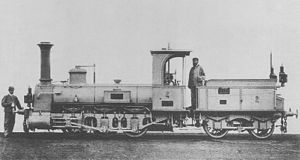SKV 1-3
| SKV 1–3 MÁV series XX / 387 ČSD series U 35.1 |
|
|---|---|
|
Factory photo of No. 2 (1873)
|
|
| Numbering: |
SKV 1–3 MAV XX, 6901–6904 MÁV 387,001–004, ČSD U 35.101–104 |
| Number: | 4th |
| Manufacturer: |
Sigl , Wiener Neustadt MÁVAG , Budapest |
| Year of construction (s): | 1873, 1897 |
| Retirement: | at ČSD until 1965 : until 1956 |
| Axis formula : | C n2 |
| Gauge : | 1000 mm ( meter gauge ) |
| Length over buffers: | 9,565 mm (with tender) |
| Length: | 6,035 mm |
| Height: | 3,200 mm |
| Total wheelbase: | 2,100 mm |
| Smallest bef. Radius: | 50 m |
| Empty mass: | 13.7 |
| Service mass: | 15 t |
| Friction mass: | 15 t |
| Wheel set mass : | 5 t |
| Top speed: | 25 km / h |
| Indexed performance : | 138 hp |
| Coupling wheel diameter: | 960 mm |
| Driving wheel diameter: | 960 mm |
| Control type : | Stephenson |
| Number of cylinders: | 2 |
| Cylinder diameter: | 290 mm |
| Piston stroke: | 500 mm |
| Boiler overpressure: | 8.5 bar |
| Number of heating pipes: | 76 |
| Grate area: | 0.75 m² |
| Radiant heating surface: | 3.66 m² |
| Tubular heating surface: | 36.70 m² (in contact with water) |
| Evaporation heating surface: | 40.36 m² (in contact with water) |
| Service weight of the tender: | 10.0 t |
| Water supply: | 3.0 m³ |
| Fuel supply: | 1.2 t (coal) |
The No. 1 to 3. Were meterspurige narrow gauge - Tender locomotives the Selmeczbánya keskenvágányu vasút (SKV) in the then upper Hungary .
history
The Selmeczbánya keskenvágányu vasút was the first public narrow-gauge railway in what was then the Kingdom of Hungary . The company procured three separate tender locomotives from Sigl in Wiener Neustadt which corresponded to the standard-gauge locomotives built at the time.
After the nationalization of the railway line, they became the property of the Hungarian State Railways (MÁV), where they were classified as XX series. The MÁVAG 1897 still gave an identical fourth locomotive.
After the First World War , the area of Upper Hungary became part of Czechoslovakia . The locomotives were now part of the Czechoslovak State Railways (ČSD) inventory . In 1925 it was given the new series designation U 35.1. The route was now run under the name "Hronská Breznica - Banská Štiavnica".
Because of the steep and winding route, a conversion to the standard gauge was started in 1940, which was completed in 1949. With that, the locomotives lost their traditional area of application. Two of the locomotives were transferred to the Göllnitztalbahn (Mníšek nad Hnilcom - Smolnícka Huta), where they were retired by the ČSD in 1950 and 1956.
The U 35.103 and the U 35.104, however, came to the pioneer railway in Košice in 1950 . The U 35.103 was in service there until 1962. In 1965 it was to be handed over to the Transport Museum Košice. There, however, they were not interested in the locomotive and so it was scrapped in 1965.
technical description
The machines corresponded to the basic principles of the Wiener Neustädter Lokomotivfabrik for three-axle locomotives, namely outer frames with Hall cranks and a Stephenson control. They were coupled to a two-axle tender.
The locomotives were able to haul 497 t on the level route and 30 t on an incline of 25 per thousand. Their top speed was 25 km / h.
See also
- List of locomotive and multiple unit series of the MÁV
- List of locomotive and multiple unit series of the ČSD
literature
- Karel Just: Parní lokomotivy na úzkorozchodných tratích ČSD . Vydavatelství dopravní literatury Ing. Luděk Čada, Litoměřice, 2001 ISBN 80-902706-5-4
- Jindřich Bek, Zdeněk Bek: Encyklopedie železnice - Parní lokomotivy [3] . Nakladatelství corona, Praha, 2000 ISBN 80-86116-20-4
- Josef Motyčka: Encyklopedie železnice - Parní lokomotivy [5] . Nakladatelství corona, Praha, 2001 ISBN 80-86116-23-9
- Helmut Griebl: ČSD Steam Locomotives , Vienna 1969
- Mihály Kubinszky (ed.): Hungarian locomotives and railcars , Akadémiai Kiadó, Budapest 1975, ISBN 963-05-0125-2
